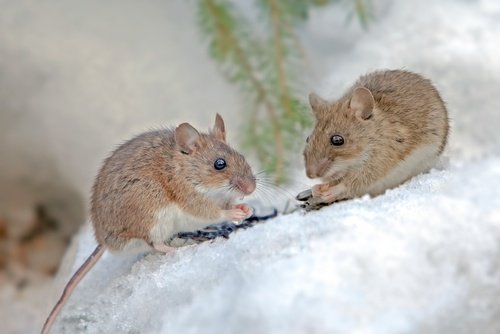Cooler weather prompts rodents to head indoors looking for food sources and places to nest. If your house or commercial property isn’t protected against mice infestation, they may just take that as a sign that they are welcome to come in!
Identify a Mouse Problem
If you have just a small mouse problem, you may not notice it right away. Mice like to stay out of sight so you probably won’t see them until the population grows. But mice are prolific breeders, so just a few can turn into a serious infestation in a short amount of time.
Some of the telltale signs of a mouse problem include:
- Droppings. Kitchen counters, drawers, and corners of cabinets are places where mice are often looking for food and leaving a trail of droppings behind. These look like small grains of rice that are black or dark brown. If you find them, you must disinfect the area as they can carry serious diseases.
- Noises. Mice are active at night, so scurrying or other mysterious noises in the evening may be signs of a mouse problem.
- Gnawing. Mice are avid chewers, so if you notice holes in food packages or on furniture, you may have a problem with mice.
Get Rid of Mice and Prevent Infestations
Here’s how to practice rodent control by getting rid of mice or preventing one:
1. Address Entry Points
Whether you already have a mouse problem or want to prevent one, blocking entry points is critical. Reduce the opportunity for mice and other pests to get inside your home by sealing up cracks and crevices in the foundation roof and siding. Weather-proofing and caulking keeps heat inside in the winter–and keeps rodents out. Cover vents securely with screen and keep doors closed when not in use.
Read More: [Infographic] Mice Fact or Fiction
2. Eliminate Food Sources
Mice look for easy access to food so keeping it put away is helpful. Pet food can be a particularly easy target for rodents. Keep your pantry safe from mice by storing dry foods in plastic or glass containers. Rodents are easily able to gnaw through paper and cardboard boxes that food comes in.
Garbage can also be an easily accessible food source for mice. Be sure your outdoor and indoor garbage cans have tight fitting lids and don’t have holes or other entry points.
3. Storage
Your attic or garage may contain a myriad of food sources and private areas for nesting. Cardboard boxes are one of the worst options for storage. Storing everything in plastic, sealable containers will block rodents from being able to access your Christmas ornaments, grandma’s old quilt, or other items you have in storage.
Read More: The Costly Damage Associated with Rodents in Your Home
4. Keep It Clean
Mice are attracted to clutter and crumbs. Sweep regularly, particularly in hidden spots such as under the stove and refrigerator. Mice like to make nesting spots in soft, cluttered spaces. Keep your home tidy to avoid providing a place for them to make a home inside of your home.
5. Home Maintenance
Mice need water sources, so aim to limit access to this. Leaky faucets and pipes provide a perfect opportunity for rodents to get the water they need. Check under sinks and around bathtubs, as well as outside around drainage areas.
Firewood, shrubs, tall grasses and other items surrounding your home act as an invitation for rodents to nest near your home. This eventually provides them with more access. Keep shrubbery and mulch at least a foot or two away from your home.
6. Professional Rodent Control
To eliminate worries about rodent control over the winter, consider contacting a pest control professional to inspect, exterminate current infestations and provide a plan for prevention.
For rodent control in Houston, consider contacting Cypress Creek Pest Control to help with mouse problems or other critters you may be needing to keep out.



